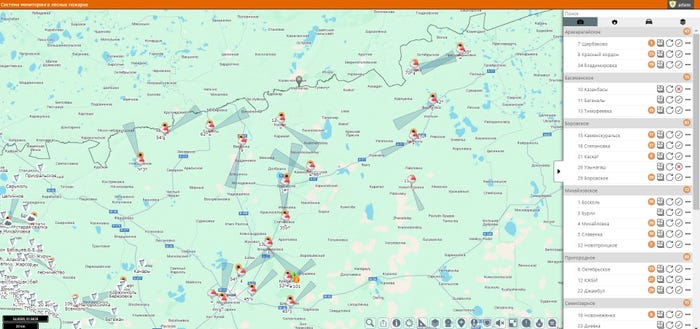Beeline Kazakhstan uses AI and cameras on antenna masts to detect forest fires
Beeline Kazakhstan, a Veon subsidiary, has developed an AI solution analyzing footage from cameras atop its antenna masts to detect forest fires.

Veon-owned operator Beeline Kazakhstan has recently announced the deployment of its fire detection solution Orman-AI in the country's Kostanay region. It relies on computer vision technology developed by Beeline, and is used by the region's fire guards for faster response.
The project is the result of a partnership between Beeline and the Department of Natural Resources and Environmental Management of the Akimat of the Kostanay Region, with thousands of images used to train Orman-AI to distinguish smoke from other phenomena like fog.
So far, 34 cameras with a range of 25km have been placed on top of Beeline's antenna masts in the region. They complete a 360-degree turn every ten to 12 minutes, with live footage from the cameras fed to the Orman-AI for frame-by-frame analysis.

A map showing the cameras' location. (Source: Beeline Kazakhstan)
In case a possible fire is detected, an alert is sent to the monitoring center which contains location of the fire, with an error margin of up to 100 meters. Further assessment can be done by UAVs, preventing the need to send workers to the area.
Forest fires are an issue causing problems worldwide, and they have been exacerbated by climate change in recent years. In Kazakhstan, it caused damage to 103,000 hectare (ha) of land in 2022. Last year, a forest fire in the Abai region killed 14 people.
Faster response
Beeline says the solution has reduced the average forest fire area to 2 ha, down from 7.3 ha, and enabled response times of less than one hour, compared to up to three hours previously. Maxim Tsvykov, head of new business at Beeline Kazakhstan, told Light Reading during an interview that the solution has so far detected around 50 outbreaks.
"It's kind of small figures [in terms of the] alerts amount, but with really unlimited value and effect behind the figures, because it can be just unpredictable how harmful these forest fires can be," he said, adding that early detection is key in suppressing forest fires.
.jpg?width=700&auto=webp&quality=80&disable=upscale)
Smoke being detected by Orman-AI. (Source: Beeline Kazakhstan)
While he says there have been no technological problems, Tsvykov notes that there have been some operational issues. These include stains on camera lenses, which can cause a false alarm and need to be removed by an engineer.
The project originally started in 2022 and was scaled up last year to 34 cameras. He notes that the company plans to scale up the solution this year to double the amount of cameras deployed and bring it to other regions. He notes expansion of the project should provide economies of scale.
From fire detection to generative AI
Tsvykov also says it could be used in other areas, including on agricultural land, and pointed out that Beeline had experience with using computer vision across a broad range of use cases. For example, it has developed a facial recognition solution that has been deployed across its customer-facing applications, such as its fintech app where users can be immediately issued a virtual Visa card.
A broad range of solutions based on computer vision have also been piloted with customers. Applications span worker safety at industrial sites; monitoring footfall in shops; smart city use cases like monitoring traffic; as well as agricultural use cases like counting chickens at a farm.
Beeline has been actively working on improving employees' competence in areas like data science and machine learning, Tsvykov says. He stresses that in these kinds of projects, it is necessary to provide the entire chain of the value creation.
Tsvykov also says the company is constantly evaluating what role it can play in this area. The question, he says, is whether it should focus on building technology from scratch or "find a way how to become a platform for all those nice guys who have got the expertise and assets to play on the computer vision market."
Beeline is also already involved in another area of AI technology. The company's developers used a Google core neural network to develop a Kazakh-language generative AI model Kaz-RoBERTA-conversational, or BeeBERT. Beeline says this is the first GenAI model in Kazakh and has made it available to all software developers for free. The company has started to deploy BeeBERT in customer care across its digital apps like BeeTV and its music app called hitter.
About the Author(s)
You May Also Like












